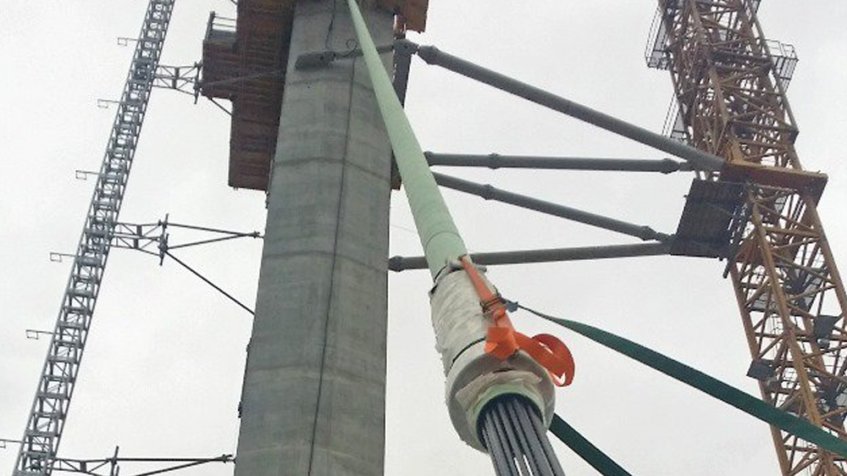Construction teams installed the 52-metre long cable at the south pylon in the Mersey estuary yesterday (27th October 2016).
It is one of 146 stay cables that will support Halton’s new 1,000-metre long reinforced concrete bridge.Gareth Stuart, project director of the Merseylink construction joint venture, said:
“This marks a momentous occasion for the project. The stay cables will be an iconic feature of this landmark structure making it one of the most recognisable bridges in the UK. We’re now entering a new, very visual phase of the bridge construction, where people will be able to see the stay cables connected to the bridge deck as it emerges across the river week by week.”
Form traveller machines are casting the deck segments from each side of the three pylons and once the concrete has reached the required strength the stay cables will be installed along the bridge.
Each stay cable consists of up to 91 individual steel strands that sit inside a stay pipe to protect the steel from the elements. More than 810 miles of the strands will be used on the project and every strand needs to be installed individually.
Merseylink design manager George Moir explains: ‘The first two strands are threaded through the stay pipe then the tower crane lifts the pipe up to the anchor point in the upper pylon where the top ends of the strands are fixed into place.
‘The bottom ends of the strands are then attached to the anchor point in the bridge deck and stressed using a hydraulic system. This enables us to get the correct level of tension needed to support that segment of bridge deck.
‘We then use a winch system through the stay pipe to winch the remaining strands up one by one. Once all of the strands have been installed they sit in parallel inside the stay pipe to form the stay cable.’
Together the 146 stay cables have a total load bearing capacity of about 53,500 tonnes. They vary in length from 41 metres to 226 metres.
The design of the Mersey Gateway bridge is based on a cable-stayed structure with three pylons. At 80 metres high, the central pylon will be shorter than the two outer pylons, which at 110 metres high (north pylon) and 125 metres high (south pylon) will give the bridge a distinctive look.
The bridge is being built for Halton Borough Council, whose council leader Rob Polhill said: “The installation of the first stay cable is a real milestone in the Mersey Gateway construction. It’s been fascinating to see the works in the estuary progress so far, and we’re now set to see truly incredible scenes as our new bridge pylons are anchored to the deck. The landscape of Halton is changing and I would encourage everyone to catch a glimpse of the exciting progress.”
The Merseylink consortium’s equity partners are Macquarie Capital Group, Bilfinger Project Investments Europe, and FCC Construcción. It is being built by a construction joint venture made up of Kier Infrastructure & Overseas, Samsung C&T Corporation and FCC Construcción.
































